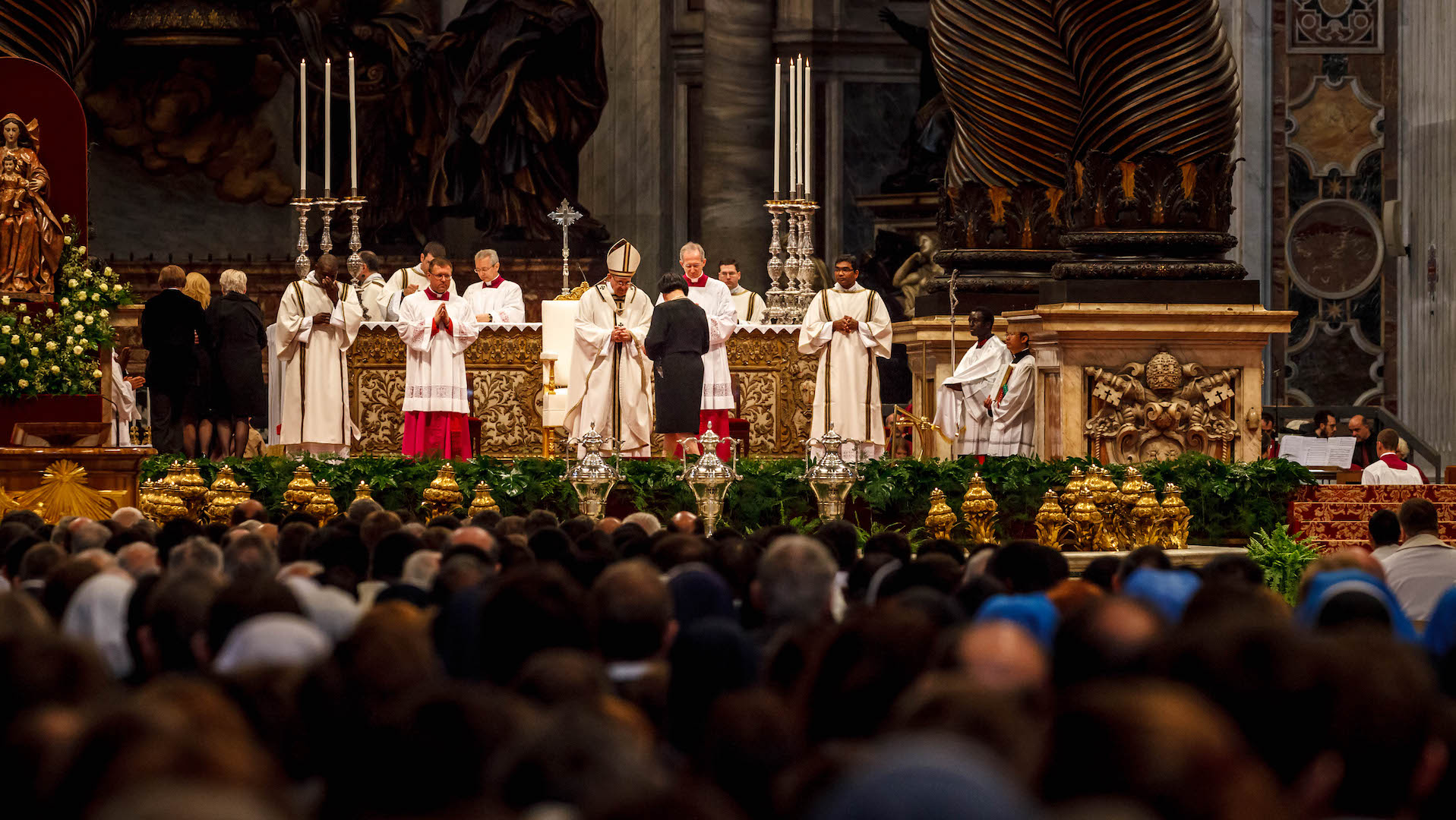
“I’m going on a pilgrimage,” said no Baptist ever.
But for millions of Catholics, religious pilgrimage is a familiar practice dating back to the earliest days of Christianity. Over time, many of the destinations and artifacts important to early Christians were eventually adopted by Catholics and became synonymous with their own pilgrimages and beliefs. So what is a Catholic pilgrimage, and how should we dialogue with Catholics about it?
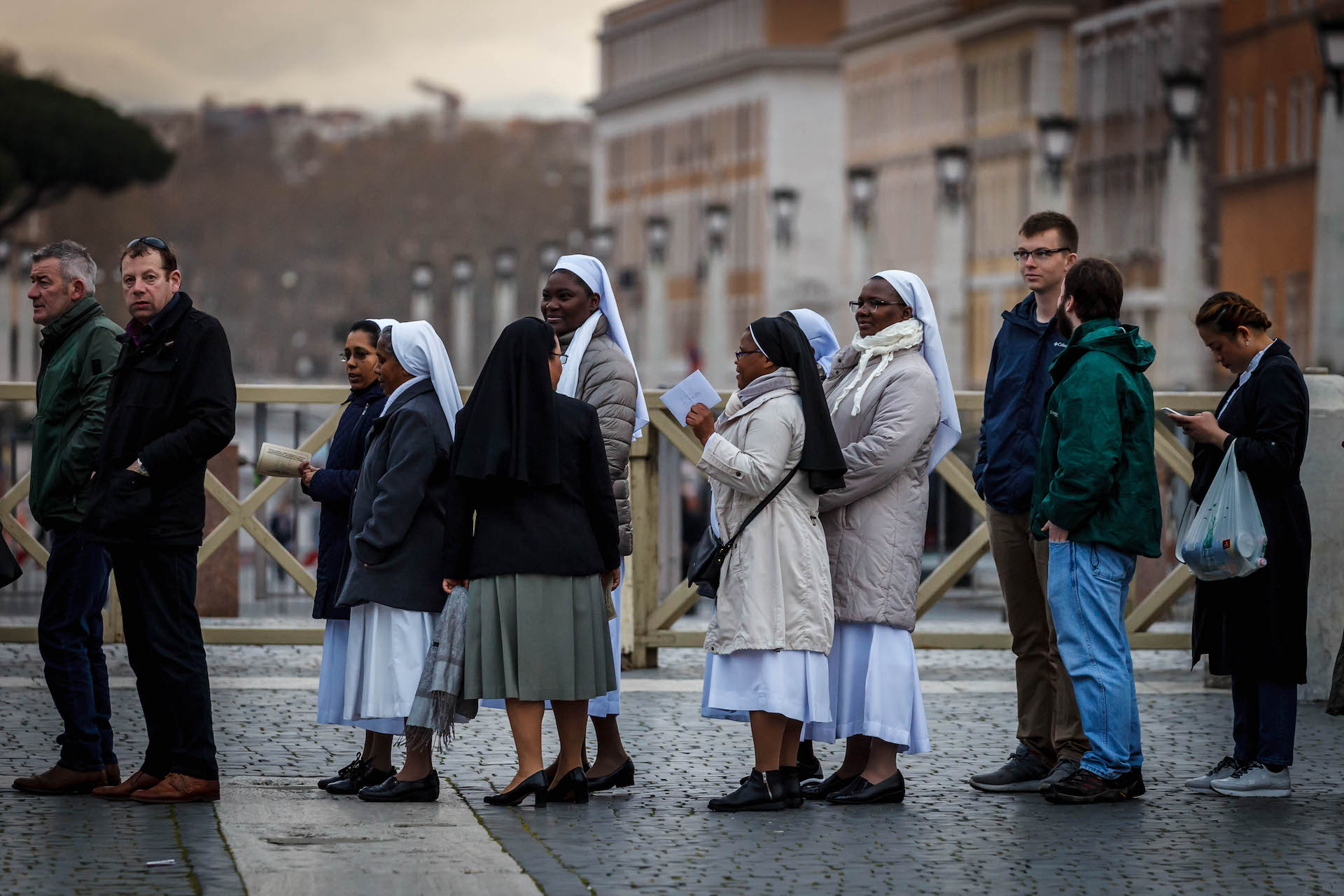
A group of African nuns wait in line to attend the Holy Thursday Mass at St. Peter’s Basilica in the Vatican in Rome, Italy. Photo by Patrick Royals
The History of Pilgrimages
The word pilgrim comes from the Latin peregrinum, or stranger. It carries an idea of intentional wandering with a purpose to honor God. A pilgrim usually visits a place notable in Christian history because of its relics or saints. A Catholic’s journey could be to show respect, to thank, or to ask help from God, Mary, or the saints. Or it could simply be to draw near to and refocus on God by visiting important sites in church history.
In the first centuries, Christians often visited the tombs of the martyrs and saints. Over time, people began to travel from afar to see these tombs and other notable sites. The first recorded pilgrimage was around AD 160 when Melito, a bishop in modern-day Turkey, visited the Holy Land to see the places of the Bible. Later in the fourth century, St. Jerome wrote, “We will have a clearer grasp of Scripture after we have gazed with our own eyes on the sites where the events of our salvation unfolded.”
Around the time the Roman emperor Constantine legalized Christianity, his mother Helena also became a Christian. With imperial authority from her son, Helena traveled from Rome to Jerusalem to find Christian relics and visit locations from Jesus’s life—some of which had become places of pagan worship.
During her journey, Helena believed she had found physical items from the life of Jesus. When she returned to Rome, she brought back pieces of what’s believed to be Jesus’s cross—referred to by Catholics as the “True Cross”—and other relics, including a twenty-eight-step marble staircase that is believed to have been the steps Jesus climbed as he entered Pontius Pilate’s palace.
As more artifacts were brought to Rome and as the city became more decidedly Catholic, it wasn’t long before the city itself became a major pilgrimage for Catholics.
Rome: The City of 900 Churches
Rome has innumerable opportunities for Catholic pilgrims to express their faith. There are nearly nine hundred churches in Rome, and many of them hold treasures that bring biblical stories to life. Whether these relics are legitimate, they can transport you back to first-century Jerusalem with only a little imagination. The wooden cross header inscribed with “Jesus of Nazareth, King of the Jews” rests at the Basilica of the Holy Cross in Jerusalem. Seeing this sign has been described by one Catholic as “one of the most precious of spiritual experiences on earth.”
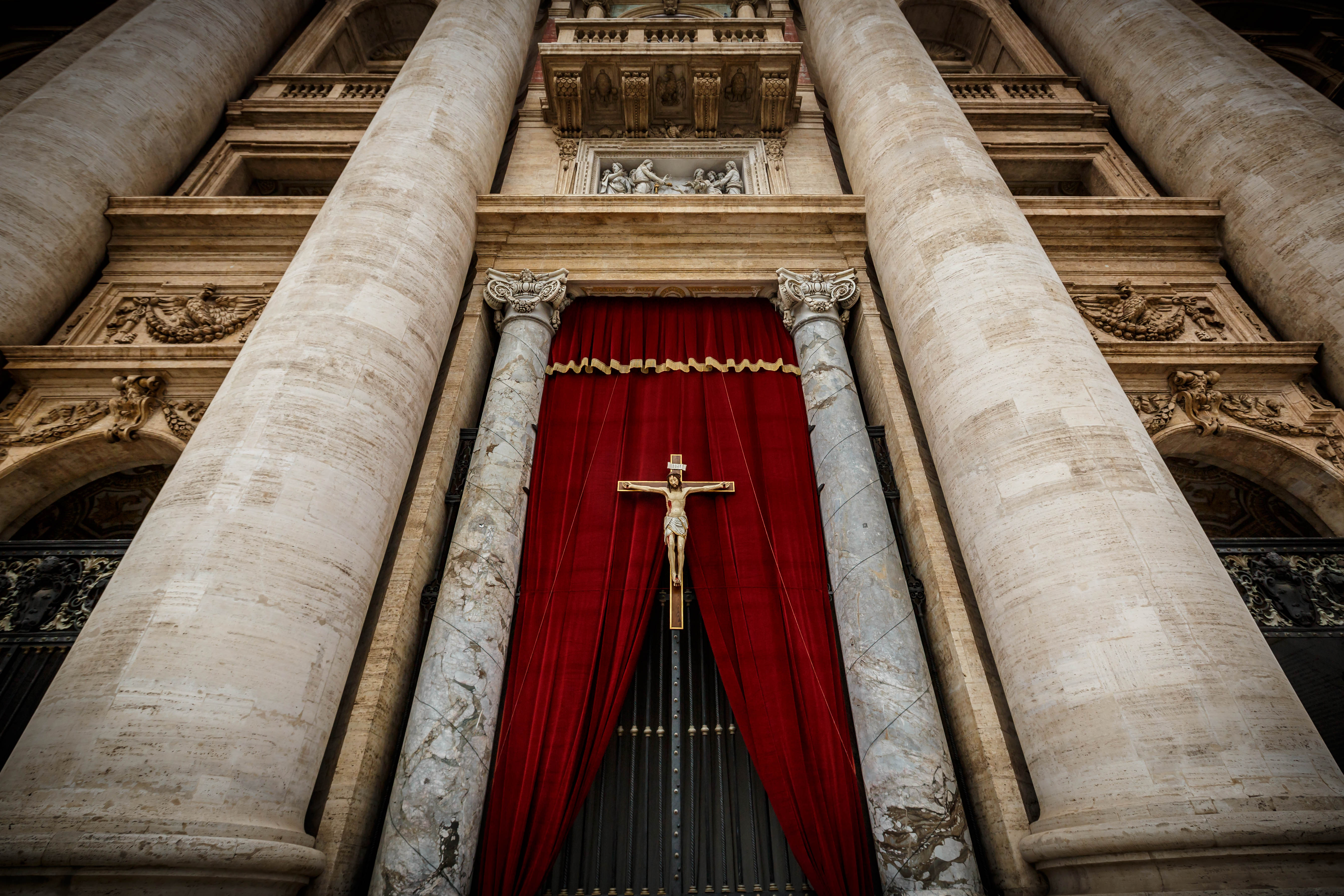
A large crucifix hangs on a dark red curtain on the facade of St. Peter’s Basilica in the Vatican. Photo by Patrick Royals.
Pilgrims also visit a church dedicated to the biblical martyr Stephen, whose remains were moved from Jerusalem to Rome. Another church was built over the place where Paul lived under house arrest. There, pilgrims can see the well where Paul may have baptized new converts. And yet another church houses the pillar where Peter may have been scourged before his crucifixion.
One church with an unusual name, called St. Paul’s Outside the Walls, is one of four basilicas in Rome known as papal basilicas and was built over the location of the apostle Paul’s tomb. Pilgrimages to these four papal basilicas during a Catholic Jubilee Year are special because they supposedly can impart remission of the temporal punishment of sin through an indulgence.
Jubilee Year
With indulgences in mind, Catholics worldwide recognize the year of Jubilee as perhaps the most auspicious time for a pilgrimage. In the year 1300, Pope Boniface VIII instituted the year of Jubilee, which he adapted from the Old Testament celebration outlined in Leviticus 25. He proclaimed that the year was a special time of pilgrimage and spiritual growth. Anyone making a pilgrimage to Rome to pray at the tombs of the apostles would be given a plenary indulgence to remit punishment for sin due in this life or in purgatory.
Over time, Jubilee came to be observed every twenty-five years. Exceptions are made in unusual situations, like Pope Francis’s recent Year of Mercy in 2016. For each Jubilee, the pope lays out instructions for pilgrimages and any conditions for Jubilee indulgences. Generally, the conditions for Jubilee indulgences are confession, communion, and visits to the four papal basilicas in Rome.
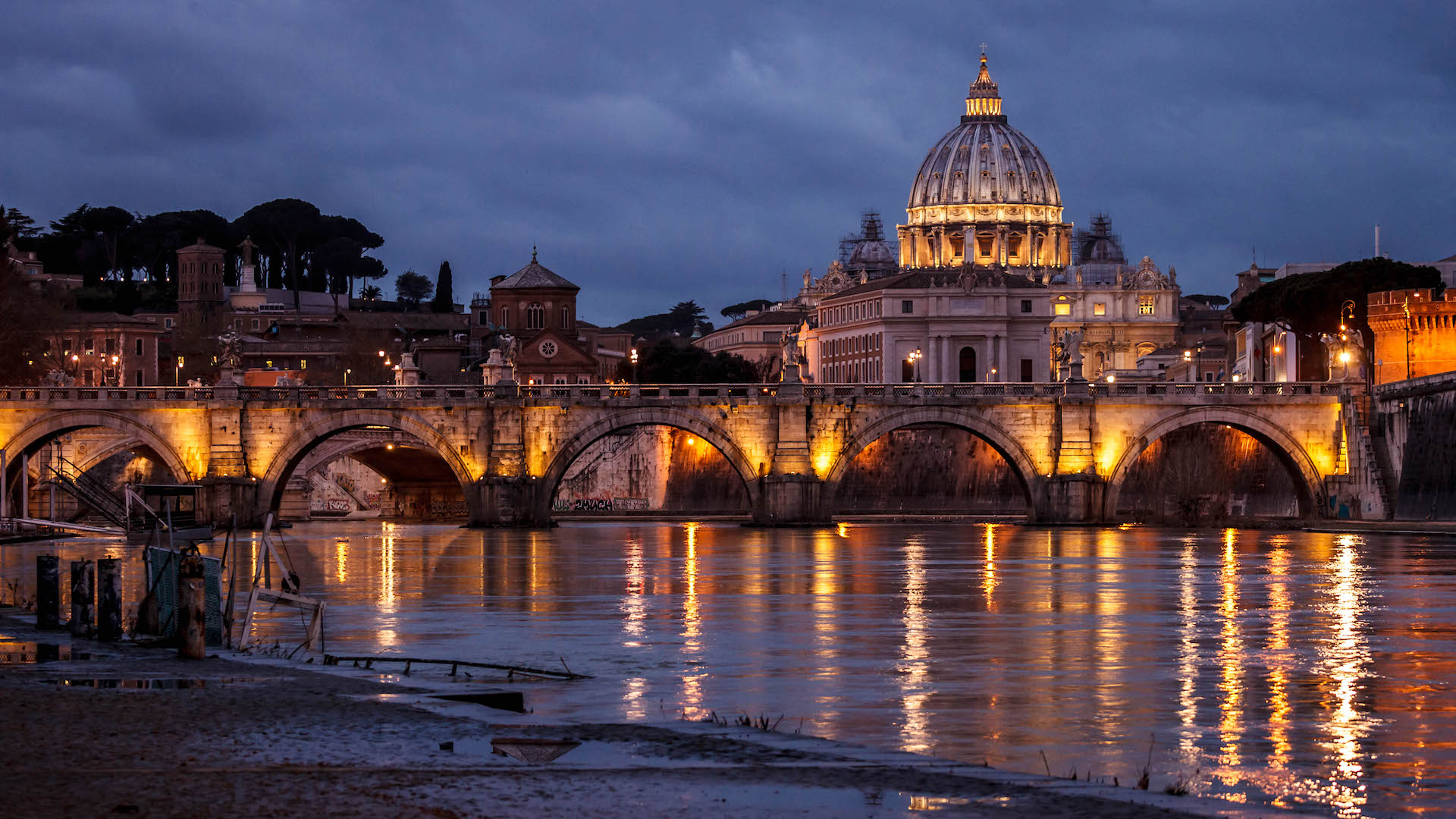
While St. Peter’s Basilica is not the official seat of the bishop of Rome (the pope), the basilica and square serve as the emotional and spirirtual center of the Catholic faith because it is built on the assumed burial site of the apostle Peter. Photo by Patrick Royals.
At the beginning and end of each Jubilee year, the pope opens and closes a “Holy Door” in each of the four papal basilicas, the most famous being at St. Peter’s Basilica in the Vatican. Catholics believe passing through the Holy Doors ushers them into God’s presence, “evoking the passage from sin to grace” as Pope John Paul II said. In 2015, Pope Francis said in his Jubilee Bull, “May pilgrimage be an impetus to conversion: by crossing the threshold of the Holy Door, we will find the strength to embrace God’s mercy and dedicate ourselves to being merciful with others as the Father has been with us.”
Vatican City
Vatican City is surely the highlight of any pilgrimage to Rome. An autonomous, sovereign state since 1929, the Vatican is the spiritual nucleus of the Catholic Church. It is ruled by the pope, who Catholics believe is the bishop of Rome and successor to the apostle Peter as the head of the Church.
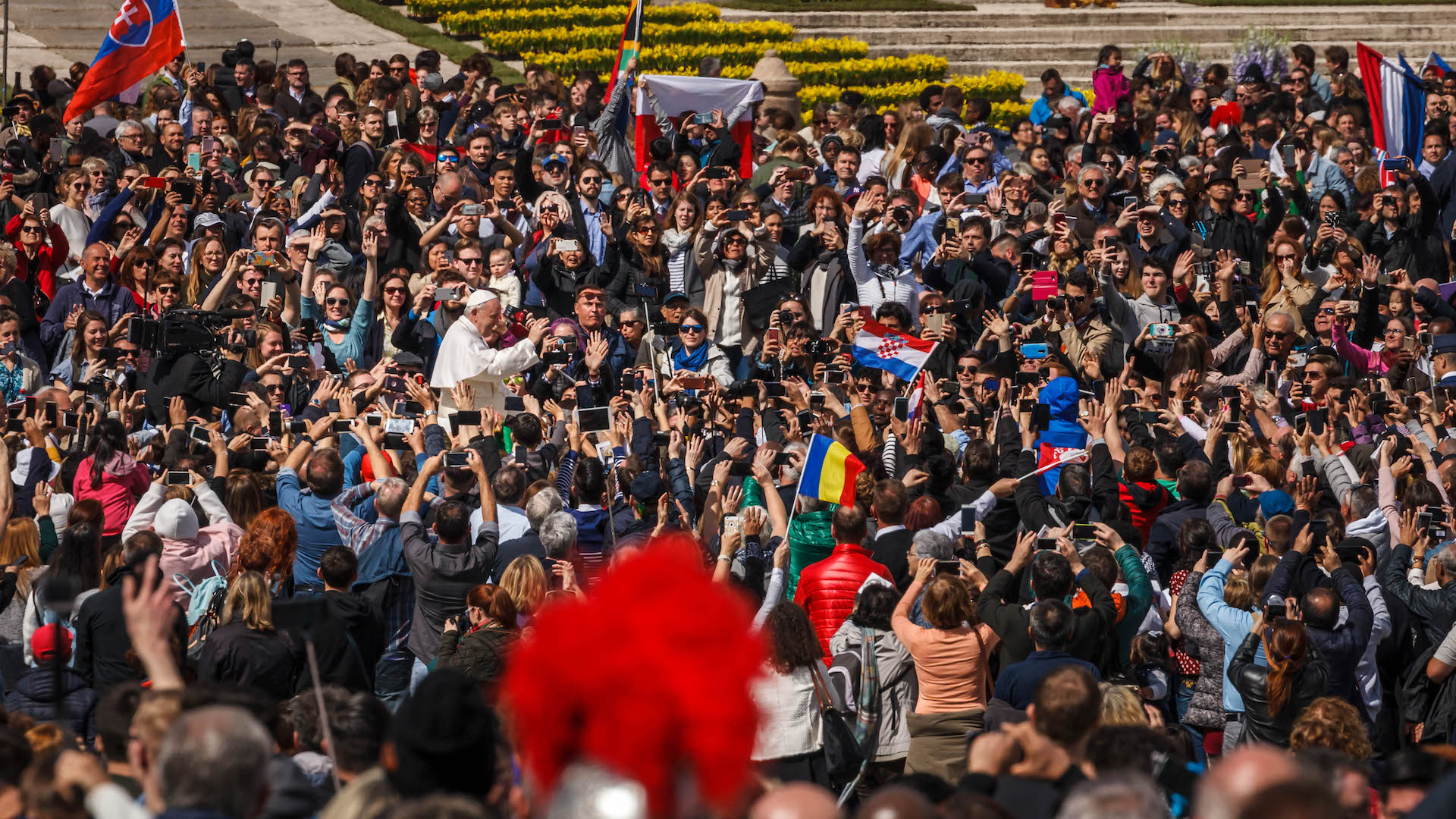
According to Catholic doctrine, the Pope has full, supreme, and universal power over the whole Church, a power that he can always exercise unhindered. Catholics visit Rome to be blessed by the pope. Photo by Patrick Royals.
Every week, the pope holds a public audience at the Vatican. During this audience, he gives teachings and readings, prays the Lord’s Prayer with those gathered, and imparts a blessing. Before dismissal, visitors can hold up religious items like rosary beads for a special blessing from the pope. The pope also appears every Sunday from his palace window where he recites a Catholic prayer and blesses the crowd. Catholics believe the pope is the vicar, or representative, of Christ on earth, and that to be blessed by the pope is to be blessed by Christ himself.
Curiosity, Kindness, and the Crux
So how should we respond when our Catholic coworker mentions a pilgrimage or if we bump into a Catholic pilgrim during our vacation abroad?
Remember at the outset that shared terms like gospel, grace, and faith have radically different meanings according to Catholic theology. Not only that, Catholics around the world have varying folk practices and beliefs about salvation. Don’t assume anyone visiting one of these sites understands the true gospel of salvation just because they affirm the terms.
“Pray that God will reveal himself to those who seek him. Pray that blind eyes will be opened to see the simplicity of the gospel.”
Instead of jumping into a conversation with assumptions, be curious. Ask questions like, “Why are you going to Rome? What will you do there? What do you hope to accomplish?”
Don’t become defensive or argumentative when you see things like the sign of the cross or rosary beads. Clothe yourself with kindness, and even affirm what you can about their spiritual interest.
If you’re traveling in Rome, you may not have many opportunities to go deep into conversation with strangers. But one of the kindest things you can do is pray. Pray that God will reveal himself to those who seek him. Pray that blind eyes will be opened to see the simplicity of the gospel. Pray that the truth will be exalted and the lies extinguished.
If you get into conversations, it may be easy to get caught up in peripheral conversations that aren’t at the crux of the gospel. Instead of discussing whether the True Cross fragment is really from Golgotha, why not express your joy for the cross of Christ that paid the penalty of your sins? Instead of debating whether expensive artwork in churches helps you worship God, why not explain how a painting touches your heart and reminds you of the gospel?
Many pilgrim practices in Rome shift the focus away from simple faith for atonement of sin and hope of glory. As we consider these issues, let’s renounce the bad and cling to the good. After all, any true believer in Jesus Christ should consider themselves as a stranger—a pilgrim—in this world (Heb. 11:13).
Let’s be faithful and faith-filled in the journey.
Madeline Arthington is a writer who serves in Central Asia.

